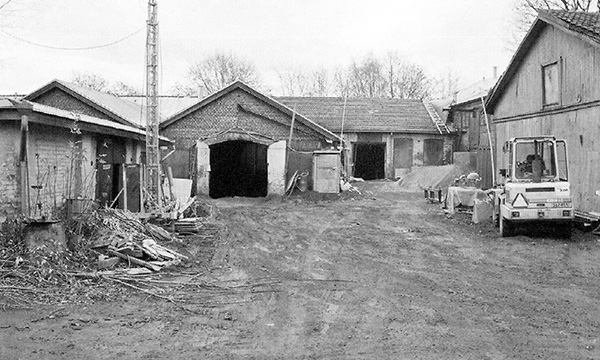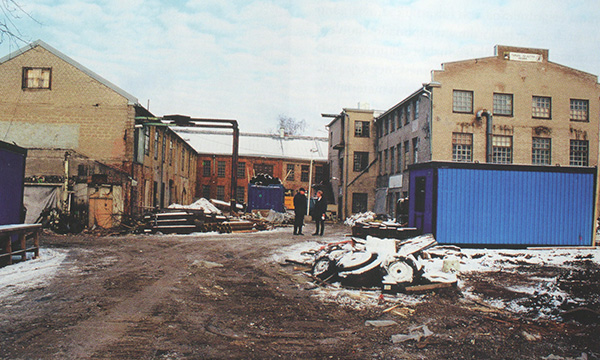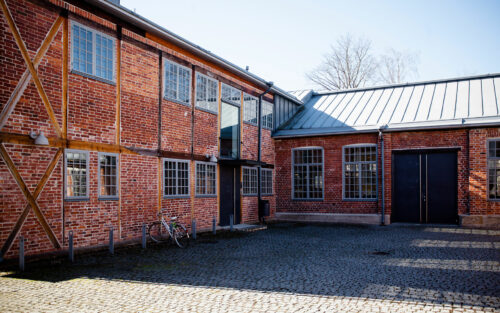Arken
Tehtaankatu 2
Construction years: 1857–2004
Old industrial buildings meet modern architecture on the Arken campus, home to Åbo Akademi’s Faculty of Humanities. From 2001 to 2004, the Åbo Akademi Foundation gave the old buildings a new lease of life, enabling all the subjects in the humanities to come together on a single campus.
Before the Great Fire of Turku in 1827, the present-day Arken block was located outside the city in an area called Piispanpelto. When the city expanded in the 1850s, individuals and industrial companies began building in the area. The first building in the block was constructed in 1854. It was a wooden residential building for Jeanette Höök, daughter of a Captain. The house was built on the plot of land that is now at the crossroads between Piispankatu and Tehtaankatu. Around the same time, Ferdinand de Ron applied for a permit to set up an ironworks in Turku. He won three plots of land in the block at auction, and the area became dominated by Åbo Jernmanufactur, Iron Manufacturers of Turku.


In 1930, the entire block was sold to the City of Turku. The deed of sale included the condition that the ironworks business could continue to operate on the premises, but some of the spaces were leased to other companies. Four years later, Fiskars Ab bought the entire complex and carried on the business under the name Finska bult, which was merged into Fiskars in the 1950s. The factory’s operations moved to Itäharju in 1952.
Business closes down
In 1971, the City of Turku reacquired the buildings in the block from Turun Tehdastalo at a public auction. The buildings would see no more industrial activity following the sale. After this, the premises served as offices for the Migration Institute of Finland, Emmaus, several sports clubs and various small businesses.
In the 1980s, an inventory was taken in the Arken block, and the area was found to be an environment of high architectural and cultural value. Since 1988, Åbo Akademi has also leased the premises for its biological collections – this is the origin of the name Arken (the ark). The old industrial buildings were also used to store objects from the maritime history collections, as well as books and publications from Åbo Akademi’s library collections.
Today, the Arken block is full of life, not least at Café Arken, a lunch restaurant. The complex consists of 13 buildings marked from A to N to facilitate orientation.
The 13 buildings in the block offer a trip back in time
he numerous buildings in the Arken block offer an interesting insight into Finnish industrial architecture from the 1850s to the 1930s.
Approaching the gateway leading to Arken’s courtyard and main entrance, one can see Åbo Järnmanufaktur’s yellow office building, which dates back to 1858. The building was probably designed by Georg Theodor Chiewitz. The only remaining wooden building in this block is building H, Kontoret. According to the drawings, the building also accommodated a plotting room, a gatekeeper’s room and a timber workshop. Later on, after the industrial activity ended, the building housed a staff canteen, as well as residences for the cook and caretaker. Since 1974, the building has served as a flea market for Emmaus.
Approaching the river, there is a two-storey factory building covered in white plaster at the junction of Tehtaankatu and Jokilatu. The building dates back to 1860. Building J was designed by G.Th. Chiewitz and serves as part of the Arken library.
Building J is connected to the oldest factory building in the block: a long, red-brick building from 1857 that follows the course of the river. This is known as building K, and it is also part of the Arken library. In the courtyard, building K splits off into two extensions, one built in 1891 (K.1) and the other in 1910 (K.2). The buildings originally served as assembly halls, and they had glass-covered gable roofs with cast-iron lattices and column supports. Today, buildings J, K, K.1 and K.2 form a single library unit. The non-load-bearing partition walls and roofs were removed during a renovation. The renovation aimed to preserve the atmosphere of the original workshop environment in the interiors and the façades facing the courtyard.
Building L, Tornet, and building M, Språklängan, together form a long mass along Kasarmikatu. Building L was designed by architect Alexander Nyström in 1915. It is adorned with columns and romantic details at the top of the tower. The tower features tall, narrow windows, as well as round windows at the top. The building was connected with building M, designed by A. Söderholm, in the same year. The red brick façade of Språklängan, with its tall, narrow windows, is typical of the factory architecture of the early 20th century.
The brick-built carpentry workshop at the crossroads between Kasarminkatu and Piispankatu was built from 1895 to 1896, and it also belongs to the Arken block. It is known as building C, Verkstad. The architect of building C is not known for sure – the building may have been the work of Carl Carlsson Armfelt or Arthur Kajanus.
The workshop is connected to a two-storey concrete building known as building D, Fabriken. The factory building is made of reinforced concrete. It was designed by A. Söderholm in 1914 and built in just eight weeks. The building has a smooth-rendered façade and tall, unadorned windows. Between the floors, the façade has a simple moulding, and there is a cornice at the top. Inside, the building has a main nave and an open roof truss with skylights that let in plenty of natural light. The iron structures of the original glass roof have been preserved, but a new glass roof has been built over them.
Immediately after Fabriken on the street side is building F, the former Tarmola grocery from 1938. This rendered brick-built shop and warehouse building was designed by Hugo Purila. Three large windows looked out onto Piispankatu, and there were separate entrances for the dairy, meat and colonial produce departments.
Next to Tarmola and Fabriken is building E, a modern extension from 2003. Formerly this was the site of Tarmola’s warehouse, but the building was removed to make way for the new two-storey building. The architect was Pekka Mäki from Sigge Architects.
Building G was completed in 2003 at the crossroads between Piispankatu and Tehtaankatu, and it was designed by Pekka Mäki from 2001 to 2004. The building contains Åbo Akademi’s Fortbildningscentralen and Centret för livslångt lärande (CLL). The structure consists of two buildings joined to each other at their edges and connected by a recessed glazed entrance. The buildings are connected by a bridge on the first floor above ground level. This is the corner where the first building in the block was built in 1854.
Café Arken is in building N in the courtyard. This red-brick building was constructed in 1857 according to a design by G.Th. Chiewitz. The building was the first foundry in the ironworks, and it contained smelting and drying furnaces, among other things. In 1889, the frame of the building was extended northwards and, in 1896, a lower extension was added to the short side to the south. In 1928, an extra floor and an attic were added to the building, and this is clearly visible on the façade – lightweight concrete blocks were used instead of brick for the new floor. Today, the building houses Café Arken, a lunch restaurant for students, as well as teaching rooms.
Building B, Kanslilängan, follows the same alignment as building N. This factory building from 1937 was designed by Hugo Purila, the same architect who designed the Tarmola building. The frame of the three-storey building is made from reinforced concrete, and the façade is coated in unpainted cement-lime mortar. The only decorative element on the building is the staggered southern end facing the inner courtyard. The northern end is connected to building M. Since the iron manufacturing business closed, Kanslilängan has served as premises for workshops and offices. The building has also contained saunas and changing rooms, as well as a large hall for martial arts. Today, buildings B and N are connected to an impressive glass façade, which forms the main entrance to the Arken complex. The former exterior façade of building B is now used as an internal wall in the entrance lobby. There is a glazed corridor to building G (CLL) on the second level at the end of the building. Today, Kanslilängan contains premises for clothing storage, toilets, caretakers and teaching. Levels two and three contain auditoriums, seminar rooms and work rooms.
Building A is inside the glass wall, with Auditorium Armfelt on the ground floor and the Helikon and Parnassos auditoriums on the first floor. The exterior and interior walls of the Armfelt auditorium are clad in rough-woven iron fabric redolent of the iron industry that once thrived in the area. A space opens out in front of the auditoriums, serving as the lobby of the Arken complex, as well as an exhibition space and a reception lobby for seminars and conferences.
The extensive renovation and restoration work has preserved a significant proportion of the historical factory environment in the Arken block. Today, Arken is a vibrant centre for humanities subjects at Åbo Akademi. When seminars and other events are held, large numbers of visitors can discover the interesting architecture and environment in the block.


